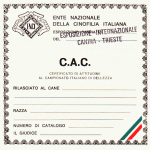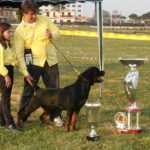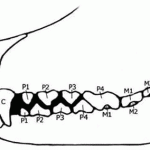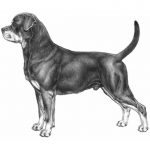Hip dysplasia, also called hip joint dysplasia is a bone disease that affects many dogs. It is hereditary and does not occur until the 5-6 months of age, sometimes even it does not occur until the dog is adult. It is a degenerative disease that can be so painful for the dog so that in the later stages may degenerate into paralysis.
It affects especially the races of large dogs, especially if the samples have not received the proper dose of calcium and minerals they need for their rapid growth. A poor diet, excessive exercise, overweight and hormonal changes are the factors that affect the onset of disease. However, it can also occur due to genetic causes or random.
What is hip dysplasia in dogs?
The term dysplasia has Greek origin and means difficulty in training and in fact hip dysplasia in dogs consists of a joint deformity coxofemorale. The hip joint or hip joint is the joint that connects the femur (the bone which is located in the thigh) the bone of the pelvis. The head of the femur has the shape of a sphere and is free to move within the acetabulum, a pelvic bone concave cavity.
As the animal grows, hips do not take the proper shape and move a little to the side or too, preventing to carry out the movements in the correct way. With time, this condition continues to escalate and the dog, in addition to feel pain, may start to limp and very difficult to play with simple actions such as sitting or climbing stairs. Although the disease is present in the genes of many dogs, Some never get to develop it.
Dogs with a genetic predisposition to dysplasia
Hip dysplasia can affect all dogs, although it is more common in large dogs. You can try prevent the condition informing and respecting all the needs in the dog at various stages of his life.
Certain breeds are particularly prone to dysplasia:
- German Shepherd
- Pastore Belga Malinois
- Pastore Belga Tervueren
- Mastiff of the Pyrenees
- Spanish Mastiff
- Neapolitan Mastiff
- San Bernardo
- Bernese mountain dog
- Italian greyhound
- Whippet
- Golden Retriever
- Rottweiler
- Siberian Husky
- Border terrier
- English Bulldog
- French Bulldog
- American Bulldog
Causes and risk factors of hip dysplasia
The hip joint dysplasia is a complex disease that is caused by many factors, both genetic and caused by the environment in which the dog lives. Although it is an inherited disease is not congenital because it does not show up at birth, but when the dog starts to grow.
The factors that affect the appearance of hip dysplasia in dogs:
- genetic predisposition: although still they have not been identified the genes that determine dysplasia, there is clear evidence that allow to affirm that it is a polygenic disease type, that is caused by two or more genes.
- Rapid growth and / or obesity: poor nutrition can promote the development of the disease. Give the puppy food too much calories can make it grow too quickly by promoting the development of the disease. Obesity in dogsIt is another factor that may favor the occurrence of disease, both in puppies than in adult dogs.
- unsuitable Exercises: The growing dogs must play and exercise to vent accumulated energies, develop coordination of movements and socialize. However, exercises involving the joints can cause damage in the growth phase. It is for this reason that, indeed, it is not recommended to train the dogs to jump when they are still puppies. The same thing happens in older dogs, for which they do not recommend exercises involving the bones. Even excessive physical activity may bring up the dysplasia.
Although the rapid growth, obesity and perform the wrong exercises can boost the development of the disease, the most critical factor is the genetics.
That is why the disease is more common in some breeds than in others, especially large as the San Bernardo, the Neapolitan Mastiff, Pastor German, Labrador, Golden Retriever and Rottweiler. However this does not exclude that also breeds of dogs of small and medium size can suffer from dysplasia. Among these are the English Bulldog (one of the most prone to develop breeds of hip dysplasia), Spaniel and the Pug; in Greyhounds, instead, The disease is almost nonexistent.
Anyhow, being a hereditary disease about which much affects the environment in which the dog lives, its incidence can vary greatly and, clearly, It can also affect the mestizos.
Symptoms of hip dysplasia
The symptoms of hip dysplasia are less obvious when the disease begins to develop and manifest themselves with increasing intensity as the dog gets older. The symptoms are:
- Inactivity
- He refuses to play
- He refuses to climb stairs
- He refuses to run and jump
- Zoppia
- Difficulty moving his hind legs
- Movements in “race rabbit”
- She walks unsteadily
- hip Stiffness
- Stiffness in the back legs
- hip Pain
- Pain in the pelvis
- Atrophy
- Pop noisy bone
- Diffficoltà to rise
- Increased muscle mass shoulder
- back curve
These symptoms can be constant or intermittent and usually they get worse after the dog has played or performed physical activity. If you notice any of these symptoms you'll want to immediately bring the dog to the vet so that you realize the ultrasound and confirm whether or not the dog has this disease.
If your dog suffers from hip dysplasia it does not mean you should stop all your normal activities, However you will need to follow some tips that will give you the veterinary to change his way of life and you will give him or medications homeopathic products that will be prescribed. You will improve the quality of his life and will continue to do so many things together.
Diagnosis of hip dysplasia
If your dog exhibits any of these symptoms may have hip dysplasia and you have to take him for a visit to the vet, palperà that will touch and hips and pelvis and will provide a radiograph of the area. In some cases it might also require blood tests and urine. The result of the visit and examination will serve to determine the dog illness.
Keep in mind that the pain and difficulty of movement depends more inflammation and damage present in the articulation that the severity of the dysplasia itself. For this, even if the result of the x-ray is a mild dysplasia, the dog may suffer much, on the contrary, Dogs that have severe dysplasia, They may suffer less.
Care of hip dysplasia in dogs
Although hip dysplasia has no cure, there are treatments that allow you to relieve pain by improving the quality of life of the sick dog. These treatments can be doctors (nonsurgical) or surgical. To determine which treatment follow, We must take into account factors such as age of the dog, dimensions, general health and severity of damage to the articulation. Clearly, the decision will affect the preferences of the veterinarian and the cost of treatment.
- The medical treatment It is generally recommended for dogs that suffer from mild dysplasia or for those who can not undergo surgery for various reasons. They usually are administered antiinflammatoryand analgesics, condroprotettori (drugs that protect cartilage), decrease in exercises, weight control and a strict diet. This therapy may be accompanied by physical therapy, hydrotherapy and messages to relieve pain in the joints and strengthen muscoli.Il medical treatment has the disadvantage of having to be carried out throughout the life of the dog and does not eliminate the dysplasia and retains but slows its development. However, in many cases it is not complicated to carry out and is large enough for the dog is in good health.
- The surgical treatmentIt is recommended when medical treatment does not give results or when the joint damage is very serious. One of the benefits of the surgery is that once the post-operative period should not follow a treatment throughout the dog's life. However, we must take into account the risks of surgery and pain that the dog will suffer after being operato.Il curative treatment for excellence is the triple pelvic osteotomy, which involves surgically reshaping the bones, joining in an artificial femur with the pelvis through a steel or titanium plate, avoiding that the femur moves.
Finally, Unfortunately, there are incurable cases for which it can not realize nor medical treatments or surgical but for which there are palliative treatments such as excision arthroplasty of the femoral head. The operation consists in removing the femoral head allowing the artificial formation of a new articulation. Avoid the pain but reduces the amount of movements that the dog can realize and can cause abnormalities in the animal's gait, however, giving a good quality of life. Finally, there is the option of replacing the hip joint with an artificial prosthesis.
Medical Prognosis of hip dysplasia
If hip dysplasia is not treated, the dog will live a life of pain and impediments. for dogs that arrive at an advanced stage of hip dysplasia, life becomes a long agony. However, The medical prognosis for dogs that receive timely treatment It is quite positive. Respecting certain restrictions in diet and physical activity, can live healthy and happy.
Prevention of hip dysplasia
Since hip dysplasia is a disease caused by the interaction between genes and environment in which the dog lives, the only effective way to prevent and eradicate it prevent two dysplastic dogs to mate. This is the reason why certain breeds of pedigree indicate if the dog has no disease or that degree of dysplasia suffers.
For example, the International Kennel Federation (FCI), uses the following classification based on letters, A to E:
- A (No sign): He has hip dysplasia.
- B (Near normal): There are clues in the x-ray light, but they are not sufficient to confirm dysplasia.
- C (light): slight hip dysplasia.
- D (Media): by radiography you notice an average hip dysplasia.
- E (Grave): the dog suffers from severe hip dysplasia in.
Dogs that have dysplasia grade C, D, They should not be used in livestock to breed, because most likely they are carriers of the genes that cause disease. Furthermore, We should always pay attention when the animal makes exercise and keep in check its power to prevent obesity. Both factors, as we have seen, influence in an important way in the appearance of dysplasia.
Caring for a dog with hip dysplasia
Even if your dog has hip dysplasia, can improve the quality of his lifegiving it the attention and care they need. Following the advice that we give below, your dog will continue to perform everyday actions, but with more confidence than before.
- One of the most effective proposals is swimming, both at sea and in the pool, twice a week. In this way, the dog develops the muscles that surround the joints without consuming them.
- Do not stop to carry around your dog because he dysplasia. Reduce the duration of the walks but bring it out more often: all outputs, in total, must add at least 30 minutes.
- If your dog suffers from obesity, it is important to re-establish its weight and keep it under control. Remember that the dog supports the weight on the hips and obesity can worsen the very dysplasia. Search croquettes light and avoid foods full of fat.
- Take him to the vet to make periodic visits to check that his health does not deteriorate. Follow his advice.
- If you notice that the dog feels a lot of pain, you can try to alleviate it with massages and applying a hot water bottle Area.
- There are chairs to ergonomic wheelchair for dogs that have hip dysplasia. If you are following a conservative treatment (nonsurgical), This could be an excellent option.
Related Posts
NEWS MOST 'INTERESTING
on our blog all the most interesting news about the world of dog world. If you are interested in some information about expo, dog health, breeding Dell'Antico Warrior, you can not find. Contact us we shall be glad to publish some post about it.







